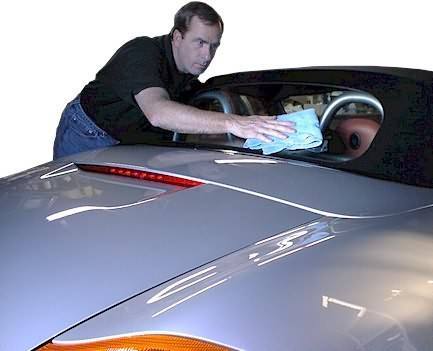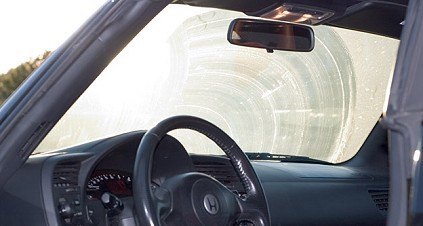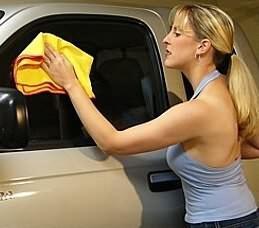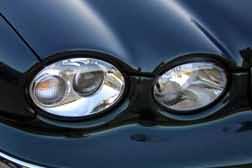Have you noticed how fantastic your vehicle looks with perfectly clean, clear windows and plastic?
I know I do.
Unfortunately, many of us ignore the windows when we wash.
Yeah, it adds a few precious minutes.
I’m guilty, myself. After all, who likes to do windows? Not so fun.
Okay, let’s be serious for a moment.
Forget the time involved in keeping your car’s windows clean.
Have you stopped to think about how dirty, hazy, water-spotted glass can be a safety hazard?

Driving your car with dirty, hazy windows on a rainy night or in heavy traffic, straining to see, is a driving impairment. Yup!
You should consider this a true danger.
In fact, the older I get the more I appreciate an unobstructed view.
Cleaning your windows is one of the most tedious car detailing tasks, but it’s worth the effort.
In addition to being a hazard, the effect of dirty glass will quickly ruin the appearance of your perfectly polished and waxed automobile.
After you have completed all other detailing tasks, put the perfect touch on your car by detailing your car’s glass.
Automotive Glass Cleaners
It seems like no two car enthusiasts can agree on the ultimate glass cleaner for their car.
Some people like ammonia cleaners, while the purists will use nothing but clear water. Whatever you use, the principles are the same: clean, dry and polish.
Believe it or not, I highly discourage the use of ammonia-based glass cleaners on your car.
While ammonia is an excellent glass cleaner in your home, it’s harmful to many car surfaces. This includes vinyl, rubber and leather.
More importantly, the use of ammonia inside your car is harmful to your health.
Use an automotive glass cleaner that specifically states it’s safe to use on window-tint film. This will also spare your plastic and vinyl surfaces.
Glass cleaners in a spray bottle work fine.
The only problem is overspray on the dash and upholstery. It’s tough to direct the spray of glass cleaners. Takes some practice.
Anyway, here’s something that may surprise you!
In the old days, professional car detailers used plain water for wiping and cleaning the windows.
They also dried glass with newspaper. Yes, really.
Unlike paper towels and most cotton towels, newspaper doesn’t leave behind lint. Further, the ink acts as a glass polish.
The big drawback to this method is only the newsprint ink on your hands.
Regardless, with the advent of microfiber detailing clothes, cleaning windows with newsprint is all but gone.
This is a good time to reveal a closely held recommendation…
SprayWay is the most amazing glass cleaner ever. Pick up that two pack!
Cleaning Car Windows
Here we go!
Start your window cleaning with the driver’s door and front passenger’s door.
If your door has a window frame, lower the window 1 inch or so. This allows access to the top part of the glass. This part should be cleaned and dried first.
Spray with glass cleaner and buff dry.
Now roll the window back up, and clean the remainder of the window.

Pay attention to the corners of the windows. This is where you will get most smears and streaks.
Don’t forget your driver’s side and passenger’s side mirrors.
Clean the inside of the windshield while you’re sitting down in the passenger’s seat.
Guess why?
Of course, it’s easier to clean from the passenger’s side. Your access isn’t obstructed by the steering wheel.
Take your time around the rear view mirror.
The thing is…
It is only glued to your windshield!
You can break it loose if you bump into the rear view mirror hard enough or at the right angle.
Anyway!
The inside of the rear window is the most difficult to reach. It should be done last.
The best technique for cleaning your rear window is to use the back side of your hand. It can guide the towel down into the corners.
Let’s face it…
Trying to use the palm of your hand will force you to be a contortionist. You will also draw strange looks from the neighbors.
Microfiber Detailing Towels
Not long ago I recommended a specific glass-detailing towel.
While the microfiber glass towels worked, I was going crazy trying to keep the different towels and their purposes straight.
I had dark blue, light blue, green, orange and pink towels.
It was nuts!
I finally came to one conclusion:
Waffle weave detailing towels are the best general-purpose towels. They work great on glass and clear plastic.

My experience is that the towels with a deep, plush nap do not work well on glass.
The best microfiber towels for glass have a low pile and a tight weave, like a polishing towel. The tight weave gives them more scrubbing power.
Be cautious of inexpensive microfiber towels.
I tell you this for one reason.
There’s a good chance that any microfiber towel you purchase in bulk through a retail chain will leave lint on your glass.
Fiber shedding is a significant problem with bulk towels. These bulk products are usually made for janitorial services by low-cost bidders in China.
The quality is often terrible!
With microfiber on glass, it’s best to use two towels. One should be damp with water or your favorite glass cleaner. The second is for drying for buffing.
Cleaning Water Spotted Car Glass
I suspect that the windshield is the most overlooked surface.
At best, you wash it when you wash the car and spray it with a few shots of glass cleaner (when you can no longer see through the haze).
Did you ever think of polishing your glass?
Normal driving will coat your windshield with a variety of contaminants. Normal glass cleaners cannot remove them.
Plus, when you think about it, your windshield has the greatest vertical forward exposure.
Right? It gets pelted with road stones and other debris.
It’s a wonder that windshields hold up as well as they do!
Automotive glass polishes that remove minor water spots and road contamination have been around for quite a while.
Admittedly, they are not always easy to find.
I highly recommend using a glass-polishing product like Griot’s Garage Glass Polish. It will keep glass clean and free of water spots.
It’s simple to do.
Just rub the polish in thoroughly with a terry cloth applicator. Then, buff dry with a terry cloth or microfiber towel.
For really tough spots on glass Griot’s Garage makes a complete glass polishing system with a 3″ polisher.

Use your glass polish with #000 or #0000 synthetic steel wool for severe water spotting (exterior only!).
The ultrafine synthetic steel wool provides a bit more cutting power for the really tough jobs.
Just please be aware of one thing!
Glass polish cannot fix glass damage from road stones and severe water spot etching. If your glass is badly pitted or etched, it may need to be replaced.
Speaking of water spots, some parts of the country have extremely hard water.
We’re talking high levels of trace elements. It’s calcium, iron, lime and other minerals found in streams and rivers.
The thing is these trace elements remain on your glass.
How?
When water from sprinklers or regular washing evaporates on your car.
It’s true. These spots attach themselves to glass.
If left on your glass for very long, hard-water spots will not wash off with shampooing or regular glass cleaners.
Eventually, they may permanently etch the glass.
So, even though you have removed the minerals causing the water spots, the outline of the spots may remain as surface damage to your glass.
The best solution: Polish the glass as soon as possible. Do it!
Windshield Wiper Care
Windshield wipers are essential for cleaning your windshield and rear window in rain or snow. They even help deal with bugs on long road trips.
The fact is this…
Wipers perform best when the rubber is in good shape and the glass is fairly clean.
Make it a habit to clean your front and rear wiper blades. Do it when cleaning your glass.
Specifically, use a damp cloth to wipe the rubber blades. It will remove bug residue, wax and other dirt buildup.

I want to stress something here:
Applying rubber dressing on your blades may cause streaking and smearing. It can also impair your vision.
The best overall maintenance of your blades is keeping them clean.
Use 303 Wiper Treatment to protect your blades, or if your wiper blades skip or squeak.
Do you have expensive after-market blades? 303 Wiper Treatment will make them last twice as long.
By the way…
A good wash fluid is just as important as wiper blades!
Pick a wash fluid with enough power to cut the grime. But don’t use something so harsh that it stains your car.
I was using a popular orange wash booster. It created these horrible white stains around my windshield.
I had enough. I finally switched to 303 Instant Windshield Washer Tablets.
Let me tell you…
It performs flawlessly for me in all conditions.
Final Touches on Automotive Glass
You need to do something if your car is a year or more old.
A close inspection may reveal a lot of dirt buildup. Where’s that you say?
In the corners of your windshield and rear window around the trim.
Use an old toothbrush or detailing brush, w/ a spray cleaner, to remove this caked-on gunk. Before cleaning, lay a towel at the base of the window to catch drips.
Spray your brush with window cleaner and shake off the excess cleaner.
Use your brush to scrub along the trim. It breaks loose the dirt.
Use the tip of a cotton swab to reach underneath trim and remove trapped dirt.
Pro Tip: If your brush won’t remove the buildup of dirt, use a sharp single-edged razor blade to gently remove the dirt from your glass.
Take care not to push your razor blade too far under rubber seals.
Seriously, this may cause leaks.
Warning: Stay clear of defroster strips on the rear window. Cutting them could render this feature useless.
Cleaning Tinted Window Film
Tinted window film is often applied to the inside of windows. It shades passengers or provide privacy.
Tinted window film is typically a thin sheet of Mylar plastic. Here’s the problem with that!
It’s easy for it to be destroyed by ammonia.
Use only water or a mild cleaner such as Meguiar’s NXT Glass Cleaner.
Have tinted film that’s been scratched? It can be polished with a cleaner designed for vinyl windows ie. convertible tops.
I recommend Plexus for polishing and regular maintenance of tinted window film.
It comes in an aerosol spray can. It’s safe for use on plastic, Plexiglas and tinted window film.
Plexus also works great on taillight and headlight covers.
Maintaining Clear Plastic

Maintaining clear plastics and window tinting is tricky.
The thing is..
These materials will scratch easily and lose their original clarity.
This applies to window tinting, convertible rear windows, headlight lenses, instrument panel lenses and other clear plastic surfaces.
With Plexus it’s simply spray and wipe.
That’s it! There’s no buffing, no mess and no waste.
Polishing Scratched & Yellowed Plastic (Including Headlights!)
The days of the glass headlight are long gone.
Most vehicles made since 1990 have plastic lenses covering the headlights.
These lenses protect expensive lamps from flying stones and road debris.
But, you know what?
Over time they discolor and become chipped from road stones.
Without proper care, plastic headlight lenses will degrade until they turn opaque. This restricts the amount of light reaching the road.
That’s concerning!
Most of the damage is caused by exposure to ultraviolet (UV) light.
Here’s what’s crazy to me.
Headlight lens discoloration becomes noticeable in as little as 2 or 3 years if you live in a southern state.
When a Kit Says The Day!
Annual polishing will restore the transparency of plastic windows and headlight lenses.
On the other extreme…
To restore yellowed or scratched plastic, such as headlight lenses, you’ll need plastic polish and a buffing tool.
Several good kits are available. One being the 3M Lens Renewal Kit.
Automotive Glass and Plastic Summary
I don’t know anyone who likes doing windows.
But this chore can be much easier. It’s about the right tools and cleaners.
I personally hated doing interior windows. So much so that I…
Well, I used to rotate which windows I cleaned each time I washed.
One week, it was the windshield. The next week, the side windows.
Nowadays, with the advent of microfiber towels, window cleaning is much easier.
After cleaning your car’s windows and polishing the clear plastic, it’s time to Detail and Treat Trim!
